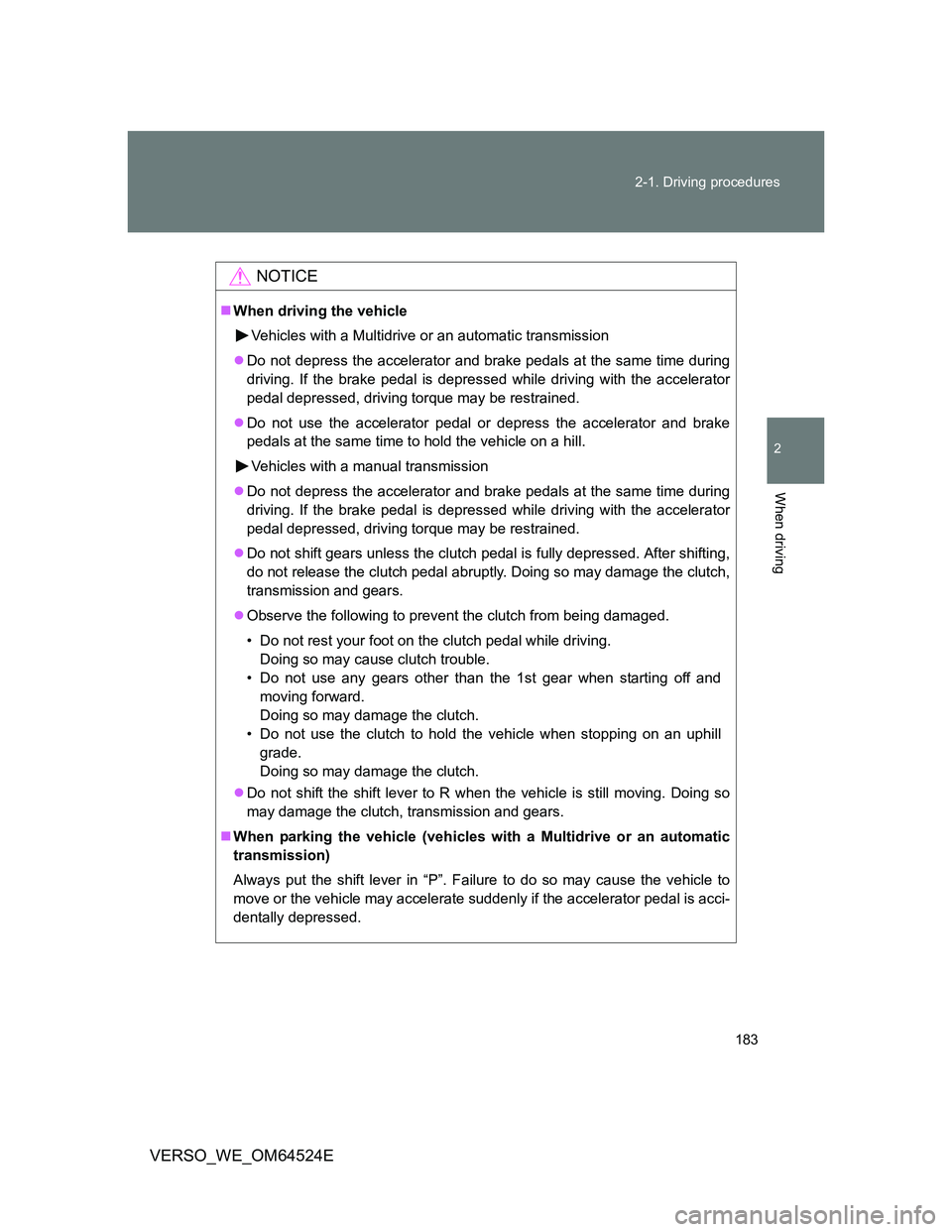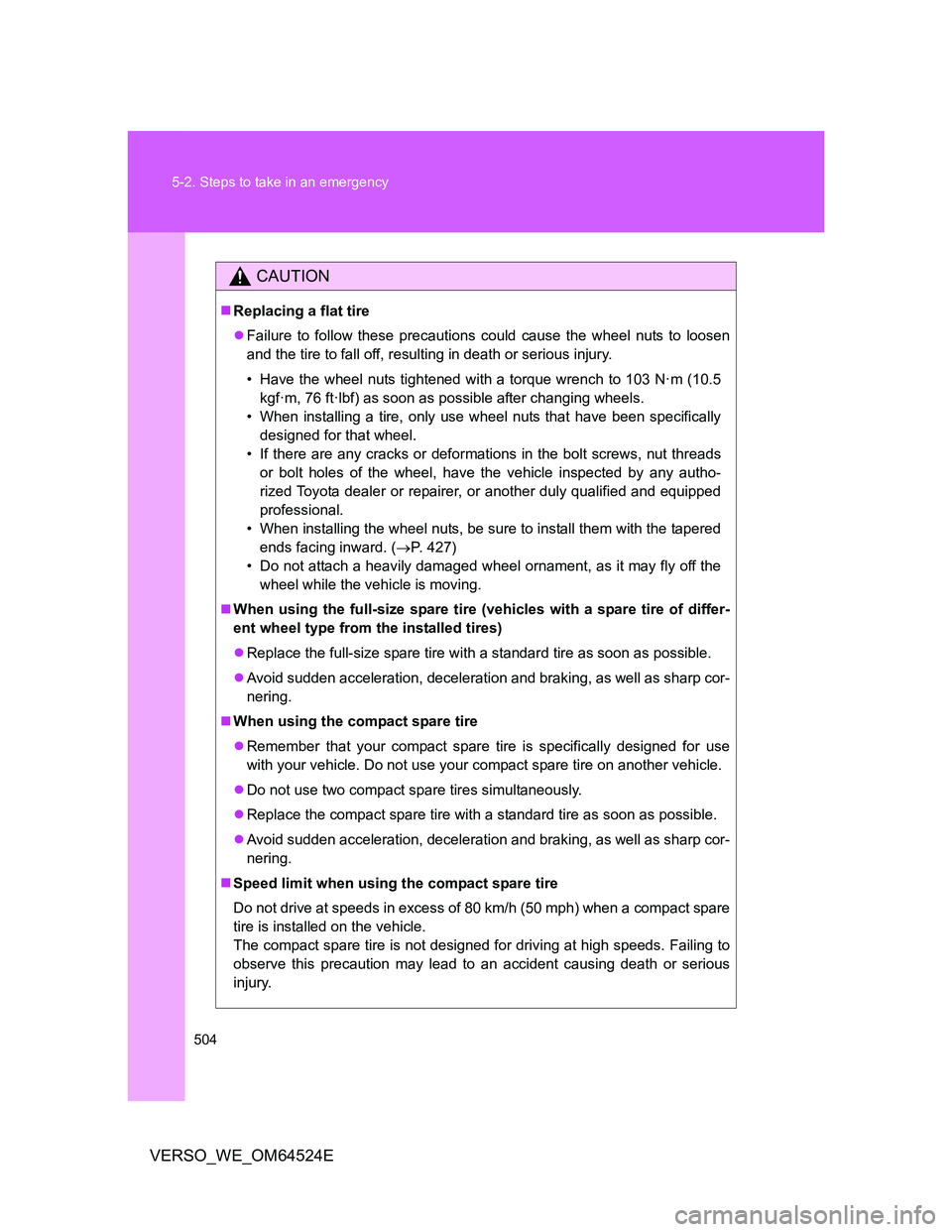Page 183 of 588

183 2-1. Driving procedures
2
When driving
VERSO_WE_OM64524E
NOTICE
When driving the vehicle
Vehicles with a Multidrive or an automatic transmission
Do not depress the accelerator and brake pedals at the same time during
driving. If the brake pedal is depressed while driving with the accelerator
pedal depressed, driving torque may be restrained.
Do not use the accelerator pedal or depress the accelerator and brake
pedals at the same time to hold the vehicle on a hill.
Vehicles with a manual transmission
Do not depress the accelerator and brake pedals at the same time during
driving. If the brake pedal is depressed while driving with the accelerator
pedal depressed, driving torque may be restrained.
Do not shift gears unless the clutch pedal is fully depressed. After shifting,
do not release the clutch pedal abruptly. Doing so may damage the clutch,
transmission and gears.
Observe the following to prevent the clutch from being damaged.
• Do not rest your foot on the clutch pedal while driving.
Doing so may cause clutch trouble.
• Do not use any gears other than the 1st gear when starting off and
moving forward.
Doing so may damage the clutch.
• Do not use the clutch to hold the vehicle when stopping on an uphill
grade.
Doing so may damage the clutch.
Do not shift the shift lever to R when the vehicle is still moving. Doing so
may damage the clutch, transmission and gears.
When parking the vehicle (vehicles with a Multidrive or an automatic
transmission)
Always put the shift lever in “P”. Failure to do so may cause the vehicle to
move or the vehicle may accelerate suddenly if the accelerator pedal is acci-
dentally depressed.
Page 500 of 588
500 5-2. Steps to take in an emergency
VERSO_WE_OM64524ELower the vehicle.
Firmly tighten each wheel nut
two or three times in the order
shown in the illustration.
Tightening torque:
103 N
·m (10.5 kgf·m, 76 ft·lbf)
Vehicles with a steel wheel
(except compact spare tire), rein-
stall the wheel ornament.
Align the cutout of the wheel
ornament with the valve stem as
shown.
Stow the flat tire, tire jack and all tools.
Page 504 of 588

504 5-2. Steps to take in an emergency
VERSO_WE_OM64524E
CAUTION
Replacing a flat tire
Failure to follow these precautions could cause the wheel nuts to loosen
and the tire to fall off, resulting in death or serious injury.
• Have the wheel nuts tightened with a torque wrench to 103 N·m (10.5
kgf·m, 76 ft·lbf) as soon as possible after changing wheels.
• When installing a tire, only use wheel nuts that have been specifically
designed for that wheel.
• If there are any cracks or deformations in the bolt screws, nut threads
or bolt holes of the wheel, have the vehicle inspected by any autho-
rized Toyota dealer or repairer, or another duly qualified and equipped
professional.
• When installing the wheel nuts, be sure to install them with the tapered
ends facing inward. (P. 427)
• Do not attach a heavily damaged wheel ornament, as it may fly off the
wheel while the vehicle is moving.
When using the full-size spare tire (vehicles with a spare tire of differ-
ent wheel type from the installed tires)
Replace the full-size spare tire with a standard tire as soon as possible.
Avoid sudden acceleration, deceleration and braking, as well as sharp cor-
nering.
When using the compact spare tire
Remember that your compact spare tire is specifically designed for use
with your vehicle. Do not use your compact spare tire on another vehicle.
Do not use two compact spare tires simultaneously.
Replace the compact spare tire with a standard tire as soon as possible.
Avoid sudden acceleration, deceleration and braking, as well as sharp cor-
nering.
Speed limit when using the compact spare tire
Do not drive at speeds in excess of 80 km/h (50 mph) when a compact spare
tire is installed on the vehicle.
The compact spare tire is not designed for driving at high speeds. Failing to
observe this precaution may lead to an accident causing death or serious
injury.
Page 560 of 588
560 6-1. Specifications
VERSO_WE_OM64524E
Tires and wheels
16 inch tires
Tire size205/60R16 92V,
T145/70D17 106M (compact spare)
1ZR-FAE and
2ZR-FAE engines
Tire inflation pressure
(Recommended cold tire
inflation pressure)Vehicle
speedFront wheel
kPa (kgf/cm
2
or bar, psi)Rear wheel
kPa (kgf/cm2
or bar, psi)
160 km/h
(99 mph) or
less240 (2.4, 35) 230 (2.3, 33)
More than
160 km/h
(99 mph)270 (2.7, 40) 260 (2.6, 38)
1AD-FTV engine
Tire inflation pressure
(Recommended cold tire
inflation pressure)Vehicle
speedFront wheel
kPa (kgf/cm
2
or bar, psi)Rear wheel
kPa (kgf/cm2
or bar, psi)
160 km/h
(99 mph) or
less250 (2.5, 36) 230 (2.3, 33)
More than
160 km/h
(99 mph)280 (2.8, 41) 260 (2.6, 38)
Tire inflation pressure
(compact spare)
(Recommended cold tire
inflation pressure)420 kPa (4.2 kgf/cm
2 or bar, 60 psi)
Wheel size16 6 1/2J,
17 4T (compact spare)
Wheel nut torque 103 N·m (10.5 kgf·m, 76 ft·lbf)
Page 561 of 588
561 6-1. Specifications
6
Vehicle specifications
VERSO_WE_OM64524E17 inch tires
Tire size215/55R17 94W,
T145/70D17 106M (compact spare)
1ZR-FAE and
2ZR-FAE engines
Tire inflation pressure
(Recommended cold tire
inflation pressure)Vehicle
speedFront wheel
kPa (kgf/cm
2
or bar, psi)Rear wheel
kPa (kgf/cm2
or bar, psi)
190 km/h
(118 mph)
or less240 (2.4, 35) 230 (2.3, 33)
More than
190 km/h
(118 mph)270 (2.7, 40) 260 (2.6, 38)
1AD-FTV and
2AD-FHV engines
Tire inflation pressure
(Recommended cold tire
inflation pressure)Vehicle
speedFront wheel
kPa (kgf/cm
2
or bar, psi)Rear wheel
kPa (kgf/cm2
or bar, psi)
190 km/h
(118 mph)
or less250 (2.5, 36) 230 (2.3, 33)
More than
190 km/h
(118 mph)280 (2.8, 41) 260 (2.6, 38)
Tire inflation pressure
(compact spare)
(Recommended cold tire
inflation pressure)420 kPa (4.2 kgf/cm
2 or bar, 60 psi)
Wheel size17 7J,
17 4T (compact spare)
Wheel nut torque 103 N·m (10.5 kgf·m, 76 ft·lbf)